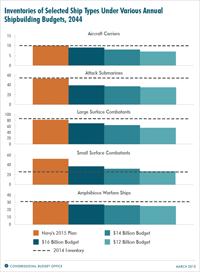Naval Services: We Need More Ships - Blog
.jpg) |
| Jonathan W Greenert |

Chief of Naval Operations Adm. Jonathan W. Greenert, Marine Corps Commandant Gen. Joseph F. Dunford and Commandant of the Coast Guard Adm. Paul F. Zukunft released a new version of their maritime strategy March 13. It is an update of the 2007 document, “A Cooperative Strategy for the 21st Century: Forward, Engaged, Ready.”
Navy Releases Revised Maritime Strategy [150227-CS21R-Final.pdf]
If the Pentagon complies with the legally mandated spending caps, the Navy has said the fleet could shrink to 260 ships. The Marine Corps would drop to 175,000 troops, down from a 2012 peak of 202,000. The current fleet of 275 ships, naval officials have argued, is insufficient to maintain a global posture.
According to the new strategy, the Navy and Marine Corps “must maintain a fleet of more than 300 ships,” including 11 aircraft carriers, 14 ballistic missile submarines to be replaced by 12 new SSBN-X versions, and 33 amphibious ships. The Coast Guard needs a fleet of 91 national security, offshore patrol and fast response cutters.
Preserving the Navy's Forward Presence With a Smaller Fleet | Congressional Budget Office
CBO estimates that, for the next 30 years, the Navy’s 2015 shipbuilding plan (which aims to increase the fleet from 281 ships in 2014 to 306 ships by 2022) would cost about $21 billion annually, on average, in constant 2014 dollars. The Navy’s estimates set the figure somewhat lower—at about $19 billion per year. Both estimates are greater than the annual average of almost $16 billion that the Navy has spent for the past three decades, which suggests that the Navy may have difficulty affording its plans. The Chief of Naval Operations’ emphasis on forward operations indicates that the Navy has committed to maintaining the largest possible forward presence under any given budget plan.
What Size Fleet Could the Navy Maintain With Smaller Shipbuilding Budgets?
Preserving the Navy’s Forward Presence With a Smaller Fleet - 49989-ForwardPresence_0.pdfCBO assessed the effects of three smaller annual shipbuilding budgets—
 $16
billion, $14 billion, and $12 billion—for the next 30 years. In all
three cases, by 2044, the fleet would be smaller than would be the case
under the Navy’s current plan (click figure to expand):
$16
billion, $14 billion, and $12 billion—for the next 30 years. In all
three cases, by 2044, the fleet would be smaller than would be the case
under the Navy’s current plan (click figure to expand):- Under the $16 billion budget, by 2044, the fleet would consist of 251 ships, 17 percent fewer than under the Navy’s current plan;
- Under the $14 billion budget, it would be 230 ships, 24 percent fewer than under the current plan; and
- Under the $12 billion budget, it would be 208 ships, 31 percent fewer than under the current plan.


No comments:
Post a Comment